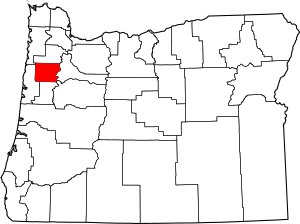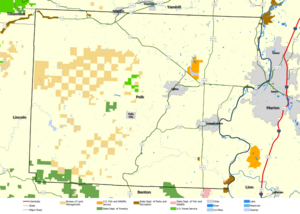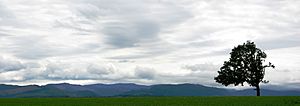Polk County, Oregon facts for kids
Quick facts for kids
Polk County
|
|
|---|---|

Polk County Courthouse in Dallas
|
|

Location within the U.S. state of Oregon
|
|
 Oregon's location within the U.S. |
|
| Country | |
| State | |
| Founded | December 22, 1845 |
| Named for | James K. Polk |
| Seat | Dallas |
| Largest city | Salem (portion) |
| Area | |
| • Total | 744 sq mi (1,930 km2) |
| • Land | 741 sq mi (1,920 km2) |
| • Water | 3.1 sq mi (8 km2) 0.4%% |
| Population
(2020)
|
|
| • Total | 87,433 |
| • Estimate
(2023)
|
89,805 |
| • Density | 118/sq mi (46/km2) |
| Time zone | UTC−8 (Pacific) |
| • Summer (DST) | UTC−7 (PDT) |
| Congressional district | 6th |
Polk County is one of the 36 counties in the U.S. state of Oregon. In 2020, about 87,433 people lived there. The main city and county seat is Dallas. The county is named after James K. Polk, who was the 11th president of the United States.
Polk County is located in the Willamette Valley, a fertile area in Oregon. It is also part of the larger Salem metropolitan area.
Contents
History of Polk County
Polk County was created on December 22, 1845. It was formed by the Provisional Legislature of Oregon from a larger area called Yamhill District. At first, Polk County covered a huge area, stretching all the way to the California border.
Over time, the county's borders changed. This happened as new counties like Benton and Lincoln were created. As more people moved south, many other counties were also formed from parts of Polk County. This left Polk County much smaller than it was originally.
The first county seat was a small town called Cynthian. In 1852, its name was changed to Dallas. This new name honored George M. Dallas, who was the Vice President when James Polk was president. Later, in the 1880s and 1890s, some people tried to move the county seat to Independence, but they were not successful.
Geography of Polk County
Polk County covers about 744 square miles. Most of this area, about 741 square miles, is land. Only a small part, about 3.1 square miles, is water.
The western part of Polk County is mostly covered in forests. These are mainly coniferous (cone-bearing) and mixed forests. Around Laurel Mountain, the forest even becomes a temperate rain forest, which is the wettest place in Oregon.
The eastern half of the county is in the Willamette Valley. The Willamette River forms the eastern border of Polk County. It separates Polk County from Marion County.
Neighboring Counties
Polk County shares borders with several other counties:
- Tillamook County (to the northwest)
- Yamhill County (to the north)
- Marion County (to the east)
- Linn County (to the southeast)
- Benton County (to the south)
- Lincoln County (to the west)
Protected Natural Areas
Polk County is home to parts of important natural areas:
- Baskett Slough National Wildlife Refuge
- Siuslaw National Forest (a part of it is in Polk County)
Population and People
| Historical population | |||
|---|---|---|---|
| Census | Pop. | %± | |
| 1860 | 3,625 | — | |
| 1870 | 4,701 | 29.7% | |
| 1880 | 6,601 | 40.4% | |
| 1890 | 7,858 | 19.0% | |
| 1900 | 9,923 | 26.3% | |
| 1910 | 13,469 | 35.7% | |
| 1920 | 14,181 | 5.3% | |
| 1930 | 16,858 | 18.9% | |
| 1940 | 19,989 | 18.6% | |
| 1950 | 26,317 | 31.7% | |
| 1960 | 26,523 | 0.8% | |
| 1970 | 35,349 | 33.3% | |
| 1980 | 45,203 | 27.9% | |
| 1990 | 49,541 | 9.6% | |
| 2000 | 62,380 | 25.9% | |
| 2010 | 75,403 | 20.9% | |
| 2020 | 87,433 | 16.0% | |
| 2023 (est.) | 89,805 | 19.1% | |
| U.S. Decennial Census 1790–1960 1900–1990 1990–2000 2010–2020 |
|||
In 2020, the population of Polk County was 87,433 people. There were over 30,000 households. The county had about 101.8 people per square mile.
Most people in Polk County are White (85.9%). Other groups include American Indian (2.1%), Asian (1.9%), and Black or African American (0.6%). About 12.1% of the population is of Hispanic or Latino origin. Many people have German, English, or Irish backgrounds.
The average age in Polk County is about 37.1 years old. About 24.3% of the population is under 18 years old.
Economy and Jobs
The main industries in Polk County are farming, forest products, manufacturing, and education.
Polk County is known for growing grapes. It has the second-largest area in Oregon dedicated to viticulture (grape growing), with about 1,322 acres.
Western Oregon University in Monmouth is a very important employer in the county. Many people work there.
Communities in Polk County
Polk County has several cities and smaller communities.
Cities
- Dallas (the county seat)
- Falls City
- Independence
- Monmouth
- Salem (a part of Salem is in Polk County)
- Willamina (a part of Willamina is in Polk County)
Census-Designated Places
These are areas that are like towns but are not officially incorporated as cities.
Unincorporated Communities
These are smaller communities that are not part of any city or census-designated place.
Education in Polk County
Polk County has several school districts for students from kindergarten through 12th grade.
- Amity School District 4J
- Central School District 13J
- Dallas School District 2
- Falls City School District 57
- Perrydale School District 21
- Philomath School District 17J
- Salem-Keizer School District 24J
- Sheridan School District 48J
- Willamina School District 30J
All of Polk County is also part of the Chemeketa Community College district. This college offers higher education and training programs.
See also
 In Spanish: Condado de Polk (Oregón) para niños
In Spanish: Condado de Polk (Oregón) para niños



